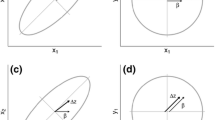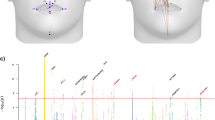Abstract
A quantitative trait locus (QTL) analysis was performed on the size and shape of the mandible in F2 mice between KK-A y and C57BL/6 J strains and the effect of the A y allele on the morphology of the mandible was analyzed. A total of 13 measurements were taken on each right mandible. By means of discriminant and canonical discriminant analyses, KK-A y males and KK males were exactly discriminated from each other. In contrast to its known effects on body weight, the A y allele reduced the overall size of the mandible. QTL analysis of the 13 measurements and on three principal components extracted from these measurements identified multiple QTLs. When F2 a/a and F2 A y/a were analyzed separately, 11 significant main-effect QTLs were identified in F2 a/a, whereas only two QTLs were identified in F2 A y/a. Although four significant interactions were identified, all were in F2 a/a. The A y allele thus made the difference in the size and shape of the mandible between strains obscure. Among mandible QTLs, those on Chrs 5 (Mssq6 and Mssq7) and 15 (Mssq14) were important. Mssq6 had an effect on the height of the posterior mandible. Mssq7 had an effect on mandible length. Mssq14 had an effect on the height of the anterior and posterior mandible. Mssq7 and Mssq14 also had an effect on the overall size. Thus, mandible QTLs have distinct and characteristic sites of action. Therefore, mandible morphology will be determined largely by the combination of these QTLs.






Similar content being viewed by others
References
Aszódi A, Hunziker EB, Olsen BR, Fässler R (2001) The role of collagen II and cartilage fibril-associated molecules in skeletal development. Osteoarthr Cartilage 9:S150–S159
Brown KS, Cranley RE, Greene R, Kleinman H, Pennypacker JP (1981) Disproportionate micromelia (Dmm): an incomplete dominant mouse dwarfism with abnormal cartilage matrix. J Embryol Exp Morph 62:165–182
Cheverud JM, Ehrich TH, Vaughn TT, Koreishi SF, Linsey RB et al (2004) Pleiotropic effects on mandibular morphology II: differential epistasis and genetic variation in morphological integration. J Exp Zool B Mol Dev Evol 302:424–435
Dohmoto A, Shimizu K, Asada Y, Maeda T (2002) Quantitative trait loci on chromosomes 10 and 11 influencing mandible size of SMXA RI mouse strains. J Dent Res 81:501–504
Festing M (1972) Mouse strain identification. Nature 238:351–352
Festing M (1973) A multivariate analysis of subline divergence in the shape of the mandible in C57BL/Gr mice. Genet Res 21:121–132
Festing MFW (1984) Quantitative characters in genetic monitoring. In: Nomura T, Esaki K, Tomita T (eds) ICLAS manual for genetic monitoring of inbred mice. University of Tokyo Press, Tokyo, pp 111–145
Francis-West P, Ladher R, Barlow A, Graveson A (1998) Signalling interactions during facial development. Mech Dev 75:3–28
Goto N, Imamura K, Sakamoto K (1977) Inheritance and growth of mouse mutation brachypodism (brp) (author’s translation). Jikken Dobutsu 26:231–238 (in Japanese with English abstract)
Goto N, Noguchi K, Imamura K (1979) Mouse strain identification by means of discriminant analysis using mandible measurements. Natl Inst Anim Health Q (Tokyo) 19:121–131
Goto N, Miura K, Imamura K, Komeda K (1981) Genetic relationships between sublines of inbred strains of mice as assessed by mandible analysis. Natl Inst Anim Health Q (Tokyo) 21:32–41
Goto N, Noguchi K, Imamura K (1982) Genetic relationships among 5 inbred strains established from common ancestor, dd mouse, as assessed by mandible analysis. Natl Inst Anim Health Q (Tokyo) 22:70–75
Goto N, Yamaoka A, Sudo T, Mannen H, Fukuta K et al (1993) Morphometric profiles of the mandible of SMXA recombinant inbred strains of mice and strain identification on the basis of mandible measurements. Exp Anim 42:41–50
Graupman P, Pan D, Konair B, Hartung S, McIvor S et al (2004) Craniofacial abnormalities in a murine knock-out model of mucopolysaccharidosis IH: a computed tomography and anatomic study. J Craniofac Surg 15:392–398
Grüneberg H (1954) Variation within inbred strains of mice. Nature 173:674–676
Huszar D, Lynch CA, Fairchild-Huntress V, Dunmore JH, Fang Q et al (1997) Targeted disruption of the melanocortin-4 receptor results in obesity in mice. Cell 88:131–141
Komeda K, Goto N (1984) Mandible analysis of NOD and NON strains of mice. Lab Anim 18:237–242
Kurihara Y, Kurihara H, Suzuki H, Kodama T, Maemura K et al (1994) Elevated blood pressure and craniofacial abnormalities in mice deficient in endothelin-1. Nature 368:703–710
Lovell DP, Totman P, Johnson FM (1984) Variation in the shape of the mouse mandible. 1. Effect of age and sex on the results obtained from the discriminant functions used for genetic monitoring. Genet Res 43:65–73
Lyons MA, Korstanje R, Li R, Sheehan SM, Walsh KA et al (2005) Single and interacting QTLs for cholesterol gallstones revealed in an intercross between mouse strains NZB and SM. Mamm Genome 16:152–163
Manly KF, Cudmore RH Jr, Meer JM (2001) Map Manager QTX, cross-platform software for genetic mapping. Mamm Genome 12:930–932
Matzuk MM, Kumar TR, Bradley A (1995) Different phenotypes for mice deficient in either activins or activin receptor type II. Nature 374:356–359
Nishihara E, Tsaih SW, Tsukahara C, Langley S, Sheehan S et al (2007) Quantitative trait loci associated with blood pressure of metabolic syndrome in the progeny of NZO/HILtJ × C3H/HeJ intercrosses. Mamm Genome 18:573–583
Pace JM, Li Y, Seegmiller RE, Teuscher C, Taylor BA et al (1997) Disproportionate micromelia (Dmm) in mice caused by a mutation in the C-propeptide coding region of Col2a1. Dev Dynam 208:25–33
Richman J, Mitchell PJ (1996) Craniofacial development: knockout mice take one on the chin. Curr Biol 6:364–367
Rivera-Perez JA, Mallo M, Gendron-Maguire M, Gridley T, Behringer RR (1995) Goosecoid is not an essential component of the mouse gastrula organizer but is required for craniofacial and rib development. Development 121:3005–3012
Satokata I, Maas R (1994) Msx1 deficient mice exhibit cleft palate and abnormalities of craniofacial and tooth development. Nat Genet 6:348–356
Suto J (2006) Identification of mutation in the growth differentiation factor 5 (Gdf5) gene in NC-brp/brp mice. J Vet Med Sci 68:1121–1124
Suto J, Matsuura S, Imamura K, Yamanaka H, Sekikawa K (1998) Genetics of obesity in KK mouse and effects of A y allele on quantitative regulation. Mamm Genome 9:506–510
Yamada G, Mansouri A, Torres M, Stuart ET, Blum M et al (1995) Targeted mutation of the murine goosecoid gene results in craniofacial defects and neonatal death. Development 121:2917–2922
Zhang B, Jain S, Song H, Fu M, Heuckeroth RO et al (2007) Mice lacking sister chromatid cohesion protein PDS5B exhibit developmental abnormalities reminiscent of Cornelia de Lange syndrome. Development 134:3191–3201
Website reference
Mouse Genome Informatics www.informatics.jax.org
Acknowledgments
The author expresses his gratitude to Ms. Saori Goto for her extensive technical contribution to this study, including animal husbandry. The author also thanks Mr. Heiichi Uchiyama for his help in photographing the mandibles. This work was supported in part by a grant from the Ministry of Agriculture, Forestry, and Fisheries, Japan.
Author information
Authors and Affiliations
Corresponding author
Rights and permissions
About this article
Cite this article
Suto, Ji. Identification of multiple quantitative trait loci affecting the size and shape of the mandible in mice. Mamm Genome 20, 1–13 (2009). https://doi.org/10.1007/s00335-008-9154-5
Received:
Accepted:
Published:
Issue Date:
DOI: https://doi.org/10.1007/s00335-008-9154-5




